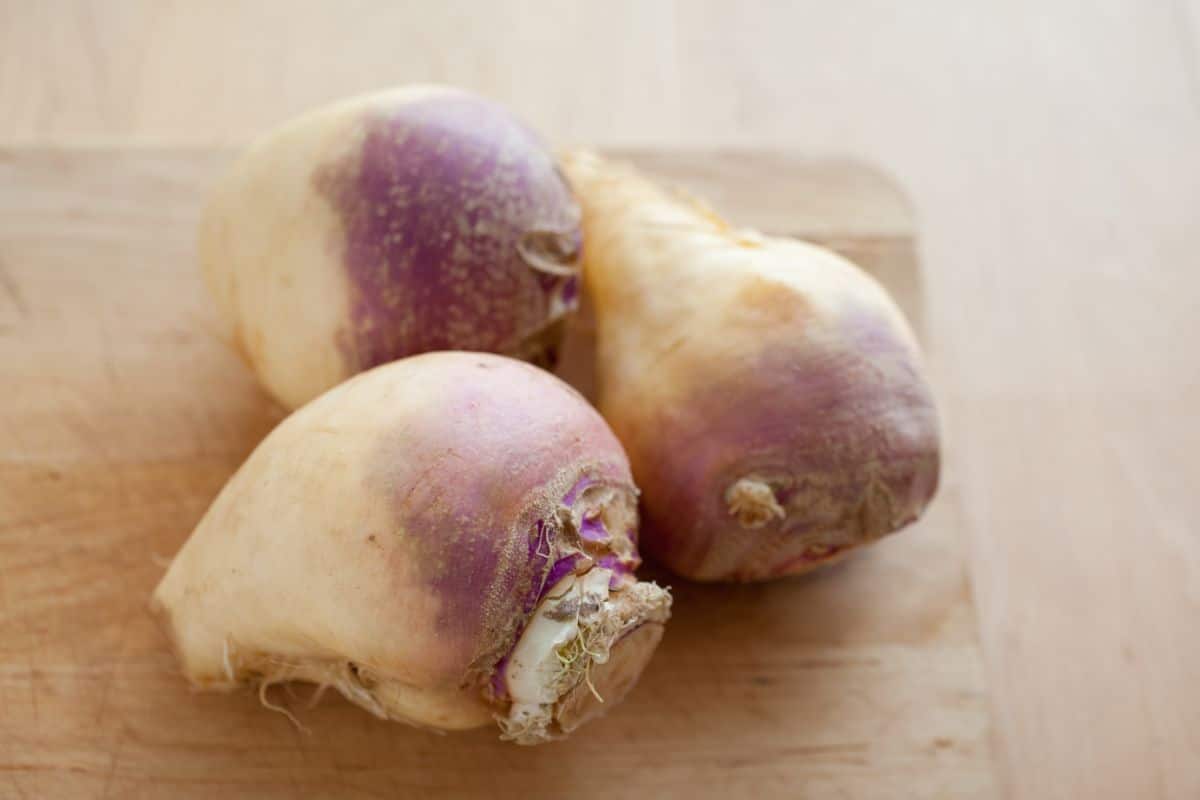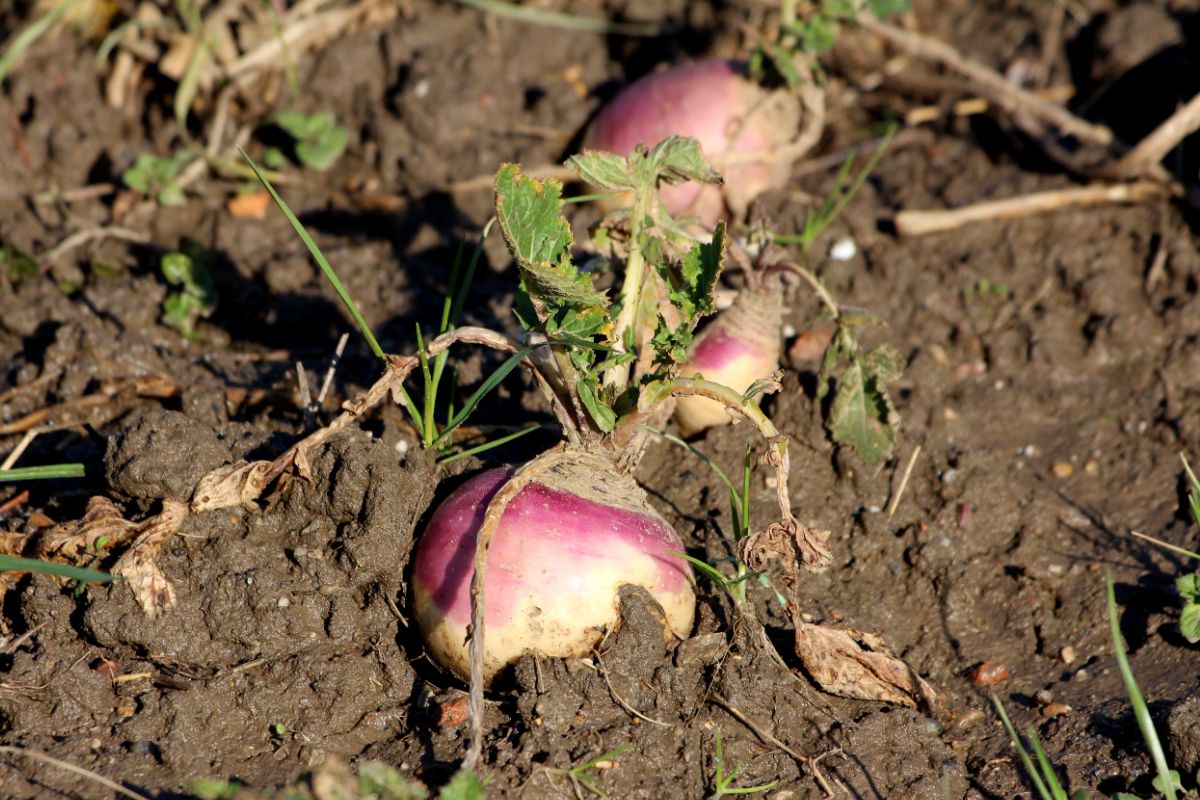These yellow-brown globes feature speckles of purple and green and can be found in the produce aisle – you may have even passed them without knowing what they are!

Unfortunately, the less attractive vegetables tend to be overlooked when a shiny, delicious tomato is sitting right next to them.
Alternatively, you may have received a rutabaga in a delivery box and have no idea how to cook with it. One glance, and you’ll believe it to be a potato, but it is so much more than this.
The vegetable first experienced a culinary rise in World War I and II as a result of food shortages (which were eaten as a stew with just water), leading the rutabaga to be underestimated and overlooked.
However, the root vegetables are certainly worth some of the spotlight. It features an earthy, vegetal taste that is usually compared to a milder cabbage, turnip, or carrot. While it pairs well with other root vegetables, it can also be eaten on its own.
Don’t let the shape and size of the rutabaga intimidate you. With a little magic on the cutting board, you’ll have this delicious root vegetable ready in no time.
What Is Rutabaga?
Rutabaga is a root vegetable that is generally considered to be a cross between a cabbage and a turnip. Despite its pungent, strong flavor and its earthy smell, it is milder than a raw turnip.
When cooked, it has a savory, sweet, and buttery flavor that is similar to a sweet potato but slightly more bitter. Due to their similar appearance, rutabagas are sometimes mistaken for turnips.
They feature a brown-yellow or purple color on the outside and a white or yellow inside. You can usually find them included in Japanese, Chinese, Scandinavian, Indian, British, European, and American cuisine. They are widely used thanks to their high nutritional value.
Rutabaga Nutrition
Rutabagas are known to be an excellent source of minerals, vitamins, antioxidants, fiber, and more. One medium-sized rutabaga (slightly less than a pound) contains:
- 33.3 grams of carbohydrates
- 143 calories
- 0.613 grams of fat
- 4.17 grams of protein
- 166 milligrams of calcium
- 8.8 grams of fiber
- 1180 milligrams of potassium
- 77.2 milligrams of magnesium
- 1.16 milligrams of vitamin E
- 96.5 milligrams of vitamin C
Rutabaga contains no cholesterol or trans fat. They are also rich in glucosinolates and antioxidants, which prevent health conditions such as cancer and heart disease.
Does Rutabaga Taste Good?
Rutabaga tastes similar to a turnip that is slightly milder. They can be described as earthy, peppery, buttery, slightly bitter, and sweet. It could be considered a cross between a cabbage and a turnip.
The outside of the vegetable features a purple color, while the inside has a yellow or white color – this is the part you cook if you decide to try it out. Those who don’t like the vegetable tend to focus on the fact that it has a bitter taste, but this is only the case when eaten raw.
In fact, many people enjoy the rutabaga’s crunchy, bitter taste when topped on salads – as you would with turnips! After you first bite into a raw rutabaga and decide it is too bitter, don’t give up entirely on the vegetable.
When cooked, most of the bitterness is removed, and you’re rewarded with a sweet, buttery, and savory flavor.
Factors Affecting The Taste Of Rutabaga

This root vegetable tends to have an earthy, nutty, and slightly sweet flavor. There are many different factors that can affect the taste of rutabaga, including the soil it is grown in, age, and cooking method.
Below, we have explored some factors that influence the taste of your rutabagas. These include:
- Age – The younger the rutabaga, the less fibrous and sweeter it tends to be. Older ones tend to be tougher and woodier to eat.
- Soil – A rutabaga’s taste can be influenced by the type of soil it is grown in. Loamy and rich soil tend to produce a more flavorful and sweeter rutabaga as opposed to sandy and poor soil.
- Cooking method – Steaming and boiling rutabagas makes them sweeter and milder. On the other hand, roasting them can enhance their nutty flavor.
If you’re looking to make the most out of the sweet flavor of rutabaga, then try using it as a substitute for potatoes in dishes like fries, stews, or mashed potatoes.
Turnips Vs. Rutabagas
As two very similar vegetables, determining the differences between rutabagas and turnips can be somewhat difficult. In fact, these vegetables are often confused with one another due to their similar tastes.
They both belong to the same family: the cabbage family. Therefore, a rutabaga can be considered a cross between a cabbage and a turnip. Despite being very similar, they have a few differences you should know about.
In terms of appearance, turnips tend to be much smaller than rutabaga. Turnips typically have a white to purple hue, whereas rutabagas have a mix of yellow, brown, purple, and white skin.
The inside of a turnip is pure white, while a rutabaga has a more pronounced yellow interior. Turnips aren’t as sweet as rutabaga when cooked in soups or stews, but they don’t have a bitter taste either.
Likewise, turnips tend to be slightly spicier than rutabaga. That said, they all feature an attractive and crispy texture. Mashing, boiling, or stewing your rutabaga or turnip is a good choice too.
Benefits Of Rutabaga
Rutabagas contain tons of health benefits, including:
- Low in calories – Incorporating rutabagas into our diet can help with weight loss which can prevent long-term (chronic) conditions including cardiovascular disorders and diabetes.
- High in fiber – They are a great source of roughage in your diet. Plus, they can help maintain a healthy gut and regulate your bowel movements. Adding these high-fiber vegetables to your diet can prevent colorectal cancer, too.
- Rich in vitamin C – Vitamin C is essential for your nervous and immune systems. It contributes to the formation of collagen – maintaining your skin’s barrier and slowing aging.
- High in potassium – To keep your muscles and nervous system working properly, your body needs potassium. This helps to protect you from strokes, prevents kidney stones, and protects against strokes.
- Prevents cancer – Rutabagas contain glucosinolates, which are chemical compounds that feature sulfur – giving these cruciferous vegetables their distinct flavor. When in your body, they break down into compounds that fight cancer.
- Contain antioxidants – Rutabagas are rich in antioxidants such as vitamins C and E and carotenoids. Here, antioxidants are necessary to reverse oxidative damage on your cells and help prevent chronic health issues. Essentially, they protect your organs and immune system from free radicals – keeping you healthy.
Rutabaga Health Risks
While rutabaga contains many health benefits, you should always eat them in moderation. If you have irritable bowel syndrome or are allergic to cruciferous vegetables, they can cause discomfort. Therefore, you may want to talk to your doctor before adding them to your diet.
How To Know If Your Rutabaga Has Gone Bad?
There are various signs you can look out for that can help you determine whether your rutabagas have been spoiled or have been stored for a while to achieve the best taste, these include:
- Mold – Mold will form on rutabagas when the vegetable has been damaged. This can be seen in gray or black spots. Once you notice mold, you should stop using the vegetable and discard it immediately.
- Soft texture – Typically, rutabaga features a dense and hard texture. When they start to spoil, they will have a mushy and soft texture. To determine whether they are fresh, you can squeeze them in your hand.
- Unpleasant Odors – If your rutabaga starts to give off an unpleasant and strong odor, then it is time to throw them out.
Final Thoughts
Rutabagas are root vegetables that can be added to a range of dishes for an extra dose of vitamins and minerals. They can be eaten both raw or cooked; however, both cooking methods produce different results.
For instance, when raw, they tend to be crunchy and bitter. When cooked, they are sweet and soft. Hopefully, this guide has informed you on everything you need to know about rutabagas and what they taste like.






